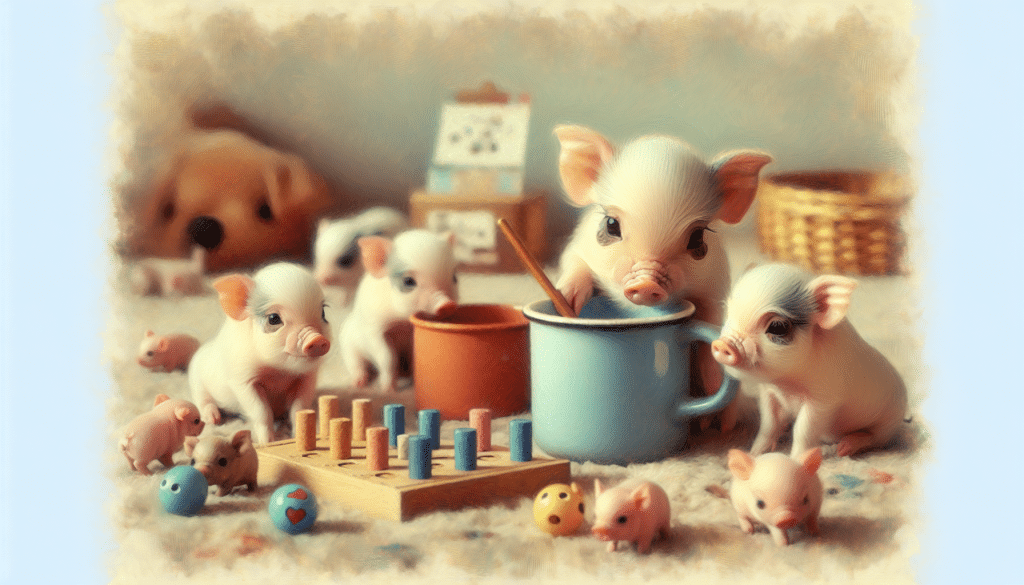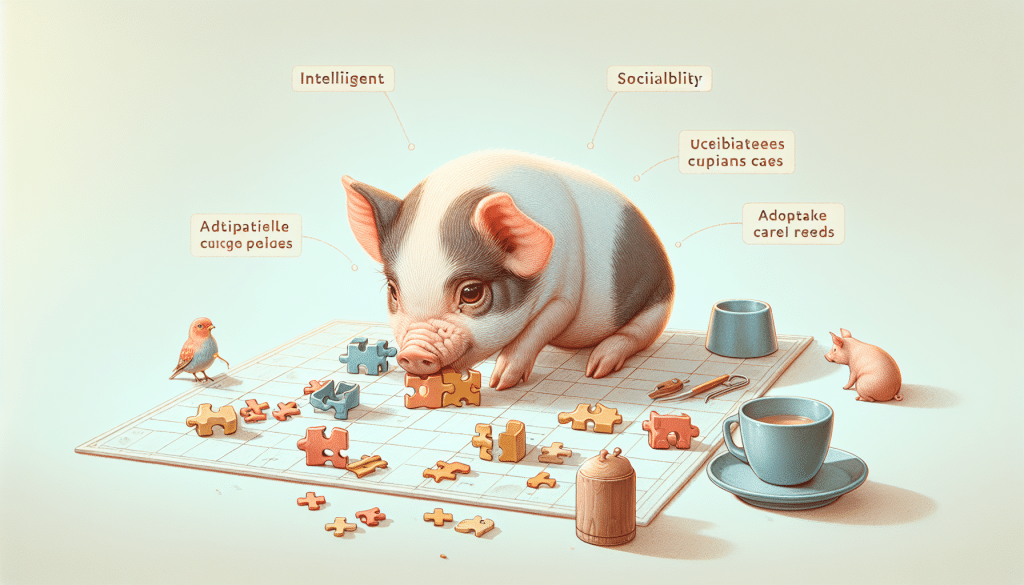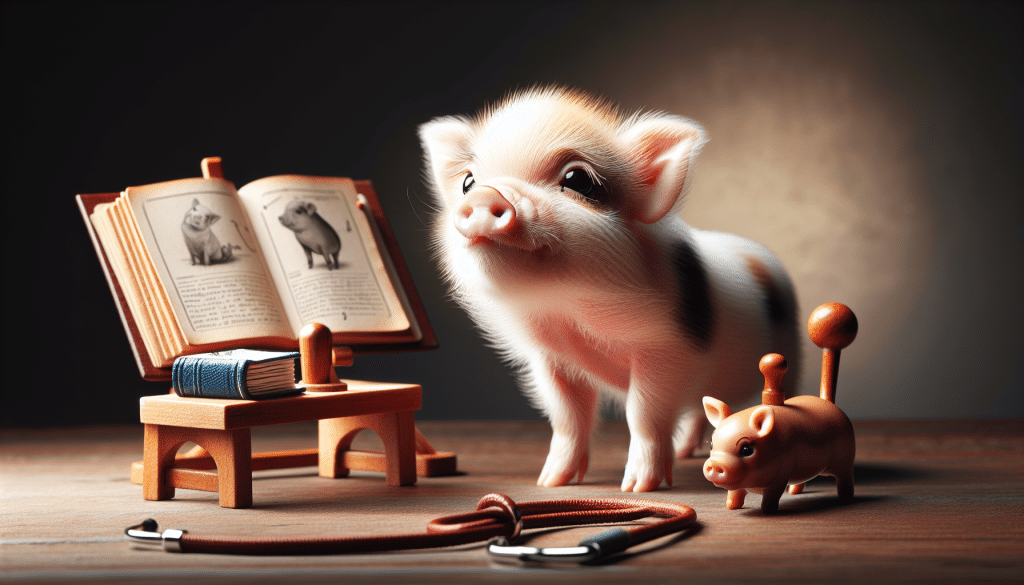Imagine a world where pet pigs roam freely, captivating everyone with their delightful antics. In this article, we explore the fascinating realm of teacup pig behavior. These pint-sized porkers have captured the hearts of many with their unique personality traits, but what exactly drives their behavior? From their social interactions to their mischievous playfulness, we delve into the intricate world of teacup pig behavior, shedding light on the intriguing traits that make these little piggies so wonderfully captivating.
Understanding Teacup Pig Behavior
Teacup pigs, also known as micro pigs or mini pigs, have become increasingly popular as pets due to their small size and adorable appearance. However, it is important for potential owners to understand the behavior of these intelligent and social animals before bringing one into their homes. By gaining a deeper understanding of teacup pig behavior, you can create a harmonious and fulfilling relationship with your pet.

Defining Teacup Pigs
Origins and Misconceptions
Teacup pigs are a result of selective breeding to create smaller sized pigs, often resembling piglets throughout their lives. Contrary to popular belief, they are not naturally occurring miniature pigs. The term “teacup” is more of a marketing name rather than a breed, as teacup pigs can be a mix of various pig breeds. It is important to debunk the misconception that teacup pigs remain small forever, as they can still grow to be substantial in size.
Physical Characteristics
Teacup pigs typically have a compact build with a snout, round body, and short legs. They come in a variety of colors and patterns, adding to their charm. Despite their diminutive size, teacup pigs can weigh anywhere from 50 to 100 pounds, depending on their genetics and individual growth patterns.
Lifespan and Growth Patterns
Teacup pigs have a relatively long lifespan for pigs, averaging around 12 to 15 years. Their growth patterns vary, with most reaching their full size within the first two years of life. However, it is crucial to provide proper nutrition and care to ensure healthy growth and development.
Behavioral Traits of Teacup Pigs
Intelligence
Teacup pigs are highly intelligent creatures, often compared to the intelligence level of dogs. They are quick learners and can be easily trained if approached with patience and consistent positive reinforcement. Their intelligence combined with their curiosity makes them keen problem solvers, so it is essential to provide mental stimulation to prevent boredom and potential destructive behaviors.
Social Interaction
Teacup pigs are naturally social animals and thrive on interaction with other pigs or their human companions. They seek out companionship and can become distressed if left alone for prolonged periods. It is important to provide ample socialization and ensure they have opportunities to interact with other animals or humans to fulfill their social needs.
Playfulness
Teacup pigs have a playful and mischievous side that adds to their charm. They enjoy exploring their surroundings and engaging in various play activities. Providing them with toys and interactive games can help satisfy their playfulness and keep them mentally and physically stimulated.

Communication and Vocalization
Understanding Pig Noises
Teacup pigs communicate through a range of vocalizations, each carrying a different meaning. They can grunt, squeal, bark, or even purr. Grunting is often a sign of contentment, while squealing can indicate excitement or distress. By paying attention to their vocal cues, you can better understand their emotional state and respond accordingly.
Interpreting Body Language
Teacup pigs also communicate through their body language. They can wag their tails when happy, flatten their ears when frightened or agitated, and even bite or nip if they feel threatened. Learning to interpret their body language can help you gauge their mood and ensure a positive interaction.
Responding to Human Interaction
Teacup pigs are known for their affectionate nature towards humans. They enjoy being stroked, cuddled, and scratched behind the ears. Positive human interaction is crucial for their emotional well-being. It is important to respond to their cues and provide them with the attention and affection they crave.
Social Structure and Hierarchy
Dominance in Groups
Teacup pigs have a hierarchical social structure where dominance plays a role. Within a group of pigs, there is usually an alpha pig who asserts dominance over others. It is important to establish yourself as the pack leader and set boundaries to prevent dominant or aggressive behaviors from developing.
Bonding with Other Animals
Teacup pigs can form strong bonds not only with humans but also with other animals. They can live harmoniously with dogs, cats, and even other pigs if introduced properly. Establishing positive relationships between your teacup pig and other animals can enrich their lives and provide them with companionship.
Interaction with Humans
Teacup pigs thrive on human interaction and can develop deep bonds with their owners. They enjoy being part of the family and participating in household activities. Regular positive interactions, training sessions, and playtime can strengthen the bond between you and your teacup pig, making them a cherished member of your household.

Feeding Behavior
Diet and Nutrition Needs
Teacup pigs require a balanced diet that includes high-quality pig feed and fresh fruits and vegetables. It is important to avoid overfeeding and provide appropriate portion sizes to maintain their weight and overall health. Consulting with a veterinarian can help ensure you are meeting your teacup pig’s specific nutritional needs.
Foraging Instinct
Teacup pigs possess a natural instinct to forage for food. They enjoy rooting around and searching for tasty morsels. Providing opportunities for them to engage in foraging activities, such as hiding treats or creating food puzzles, can satisfy their natural instincts and prevent boredom.
Feeding Schedules and Routines
Establishing a consistent feeding schedule and routine is essential for teacup pig ownership. They thrive on routine and will quickly adapt to a set mealtime. It is important to avoid feeding them excessive treats or table scraps, as it can lead to obesity and nutritional imbalances.
Teacup Pig’s Emotional Needs
The Need for Companionship
Teacup pigs are highly social animals and need regular companionship to thrive. They can become lonely and stressed if left alone for extended periods. If you are considering owning a teacup pig, it is important to ensure you can provide them with the attention and companionship they require.
Stress and Environmental Factors
Teacup pigs are sensitive animals and can easily become stressed by changes in their environment or routine. It is important to create a calm and secure living environment, minimize loud noises, and avoid sudden disruptions that may cause stress or anxiety.
Signs of Happiness and Contentment
A happy teacup pig will often display signs of contentment through their body language. They may wag their tail, make soft grunting noises, or engage in playful behavior. By observing and responding to these signals, you can ensure your teacup pig is living a fulfilled and happy life.
Training and Discipline
Housebreaking Teacup Pigs
Properly housebreaking teacup pigs is crucial for a harmonious living environment. They can be successfully trained to use a litter box or designated outdoor area. Consistency, positive reinforcement, and patience are key when teaching your teacup pig appropriate elimination habits.
Teaching Basic Commands
Teacup pigs can learn basic commands such as sit, stay, and come. Training sessions should be short, positive, and rewarding. Using treats as rewards can be highly effective in motivating your teacup pig and reinforcing desired behaviors.
Behavioral Correction Techniques
Teacup pigs, like any other pet, may exhibit undesirable behaviors that need correction. It is important to respond to these behaviors appropriately, redirecting them towards more acceptable alternatives. Punishment should be avoided, as it can create fear and damage the trust between you and your teacup pig.
Challenges in Teacup Pig Ownership
Common Behavioral Problems
Some common behavioral problems in teacup pigs include rooting, chewing, and vocalizing excessively. These behaviors often stem from boredom or a lack of mental stimulation. Engaging your teacup pig in interactive play, providing toys, and creating a stimulating environment can help address and prevent these issues.
Separation Anxiety
Teacup pigs are highly social animals and can develop separation anxiety if left alone for long periods. This can lead to destructive behaviors and excessive vocalization. Gradual desensitization, making departures and arrivals low-key, and providing mental stimulation when alone can help alleviate separation anxiety.
Destructive Behaviors
Teacup pigs may exhibit destructive behaviors such as digging, chewing, or knocking over household items. These behaviors often arise from boredom or a lack of proper outlets for their energy. Providing appropriate toys, engaging in regular exercise, and redirecting their energy towards more suitable activities can help alleviate destructive behaviors.
Conclusion: Fostering a Positive Relationship with Teacup Pigs
Owning a teacup pig can be a rewarding experience if you take the time to understand their behavior and meet their unique needs. Patience, consistency, and positive reinforcement are key to training and building trust with your teacup pig. Providing them with appropriate socialization, mental stimulation, and a well-balanced diet will ensure they lead happy and fulfilling lives as cherished members of your family. By fostering a positive relationship with your teacup pig, you can create a bond that will last a lifetime.

